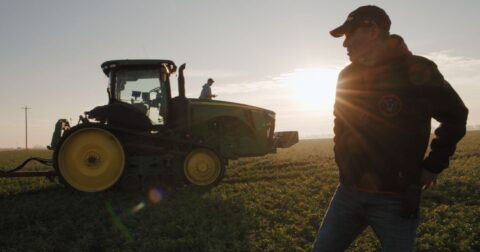Investigation
Can You Trust a ‘Certified Humane’ Pet Food Brand?
Food•6 min read
Perspective
Methane and deforestation from farming cattle isn’t magically offset by regenerative agriculture. The new documentary mostly omits this truth.


Words by Jessica Scott-Reid
Common Ground is the new documentary from the filmmakers of Kiss the Ground, the 2020 hit documentary that propelled regenerative agriculture into the mainstream — a clip even aired at a House Agriculture Committee meeting in 2021. After its original premiere at the Tribeca Film Festival last year, this followup film is now streaming on Netflix and is playing in over 75 theaters across the U.S. to coincide with Earth Day, on April 22. “The rich history of Earth Day is a perfect complement to the urgent need for regeneration and sustainable practices,” intones the film’s website. But just what is “regenerative agriculture,” and is Common Ground factual in its presentation of this supposed food-system fix?
Common Ground ultimately tells the same tale as the first film — that regenerative farming can save the planet — but this time with much more gusto, much more information and seemingly with much more at stake. The film fully utilizes the drama of the medium, employing emotional music and well-known celebrities — including Jason Momoa, Laura Dern, Donald Glover and, once again, Woody Harrelson — each writing a dire letter to their children or future children about how to save the planet. The solution is a recurring character from the original film: soil.
Unfortunately, that solution is a vastly oversimplified one, and one that omits the importance of people eating less meat to combat climate change.
While there is no single definition of regenerative agriculture, the main tenets come from a mix of Indigenous practices and modern farming methods, including the use of innovative machinery such as the roller crimper. The most common practices include not tilling the soil, planting cover crops and rotating livestock (mainly cattle) through the land to graze.
Much like in Kiss the Ground, this film argues that the practices of regenerative agriculture are a necessary alternative to our current food system. In the U.S., we rely heavily on monocropping, especially vast amounts of corn and soy grown to feed animals in confined feeding operations (CAFOs).That has wreaked havoc on our atmosphere and climate. Regenerating that soil with no-till methods, crop rotation and natural pest and weed management could restore the balance, both the first film and Common Ground argue.
The first film was wildly successful. So much so that no matter how many times scientists and science writers demonstrated that regenerative agriculture does not actually “reverse climate change,” the practices were hailed as a solution, endorsed and funded by the U.S. Department of Agriculture as “climate-friendly” farming methods.
Still, Common Ground does take a broader approach than the original film, digging into many of the intersecting problems entrenched in the American food system. It dives into the role of colonization in propping up industrial agriculture, the continued whiteness of farmland ownership and the exploitation of brown workers. It looks at the history of pesticides, the evolution of industrial agriculture and the role of the Farm Bill and government subsidies.
It builds to a crescendo of impending doom, or what the film calls the “dust bowl 2.0” of our imminent future. It’s an overwhelming and scary message — one that perfectly positions audiences to receive the saving gospel of regenerative agriculture, no matter how empty that gospel may be.

Early in the film, when regenerative grazing is first mentioned, the audience is shown a side-by-side shot of bison and cattle. This idea that the two animals are one and the same is carried on throughout the film. “Regenerative agriculture aims to bring those bovines back,” recites Harrelson, grouping grass-fed cattle in the same category as wild ruminants who once naturally grazed the land.
But cows aren’t bison, and regenerative ranching isn’t “mimicking nature,” as the film states. Jennifer Molidor with the Center for Biological Diversity explains to Sentient that comparing the two species is like “comparing apples to oranges.” Wild bison are native to the U.S., she says, so they have “evolved with and adapted to native grassland ecosystems in the West. Cattle did not.”
Cattle are not native to the U.S., and can be considered an invasive species. They behave differently, Molidor says, in important ways: “they graze differently, cluster differently, eat vegetation differently, and even regenerate differently, while also existing on the landscape differently.” She adds that “while one contributes to ecosystem health, the other cancels out most of their supposed benefits with catastrophic damage to the land, water and atmosphere.” These points are missed in the film.
Common Ground does mention the option of not eating farmed animals — but not the option of not slaughtering them. “You need animals to integrate into a regenerative agriculture system in order to restore soil,” says Dr. Mark Hyman (the creator of the pegan diet) in the film. “You don’t have to eat them if you don’t want to, but you can’t ignore the fact of science, biology and ecology.” But what science, biology and ecology make evident is that farming cattle to slaughter them means interrupting the cycle of nature. “Wild bison, in [a] true regenerative cycle, die on the land, become food and nutrients for animals and for the landscape, and are recycled into the web of life,” explains Molidor. “Cattle, on the other hand, are removed at a young age and become burgers and veal, and their milk becomes cheese for humans.”

Common Ground accurately presents the persistence of industrialized agriculture as a major risk for the death of our soil, our planet and our future. But then it positions regenerative agriculture as the savior, the solution and the only option. While facets of this comparison may be accurate, the film fails to offer a complete picture with necessary nuance and self-reflection.
For example, critics of regenerative agriculture point to the continued use of land to raise animals for profit, rather than rewilding. Rewilding is the act of restoring land to its uncultivated status. But rewilding does not typically turn a profit, as it focuses on reintroducing native flora and fauna, and essentially leaving land alone.
And most importantly, the film also never discusses the massive reduction in meat consumption required, and why that reduction would need to be even more dramatic to make the regenerative model plausible. Cattle emit a huge amount of greenhouse gas emissions, specifically methane, and that methane isn’t magically offset by regenerative agriculture, because agricultural soils are actually terrible for storing carbon.
What’s more, regenerative grazing uses far more land than industrial feedlots, and how we use land has a huge impact on climate change. In essence, if you take a forest or any other wild landscape and turn it into a farm, you stop storing carbon and release it into the atmosphere.
Research has found that regenerative farming requires 2.5 times more land than conventional methods. But about half of the world’s agricultural area is already used to farm animals and grow their feed, which makes up about 20 percent of the total land on Earth. More than doubling that in order to move all animals to regenerative practices isn’t plausible; a reduction in animal-eating would be needed. But there is no mention of this in the film. In fact, one farmer featured in the film claims that his practice of regenerative grazing can be applied worldwide.
Further, a 2018 Harvard report discovered that transitioning U.S. beef production solely to grass-fed pastured systems would actually require 30 percent more cattle to meet current demand. That would escalate methane emissions by eight percent, since grass-fed cattle have slower growth and higher methane conversion rates. There is also no mention of this in the film.
There is a brief discussion of meat alternatives in Common Ground. However, products such as Beyond Meat and Impossible Foods are described — though “clearly hav[ing] benefits to the environment” — as fake, unhealthy and “just like factory farmed meat,” relying on monocrops, and full of long lists of scary-sounding ingredients.
This is language known to be used by Big Meat to thwart the progress of plant-based meat. While the film does make quick mention of plant-based meat alternatives produced with regeneratively grown ingredients, that’s quite literally the end of the sentence. No examples of products beyond a quick shot of two boxed products, or any other details, are provided. To the tune of the Rocky theme song, Common Ground positions regenerative farmers as the small heroes the world needs: the Davids in a battle against the Goliaths of crooked government, industrial agriculture, food injustice and climate change. It works well as a rallying cry for urban gardeners, weekend activists and grass-fed beef buyers. However, the messaging is limited by its medium, and perhaps too blinded by its own subject matter, to tackle this complex and pressing issue with the nuance and critical thinking required to truly cultivate common ground.